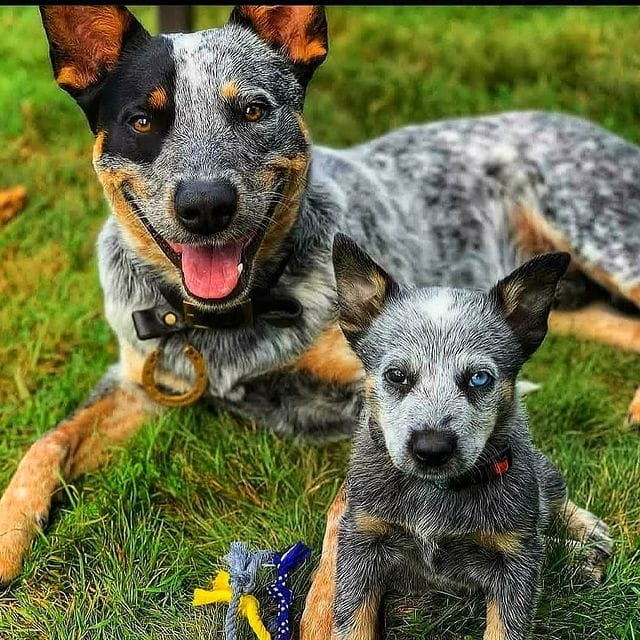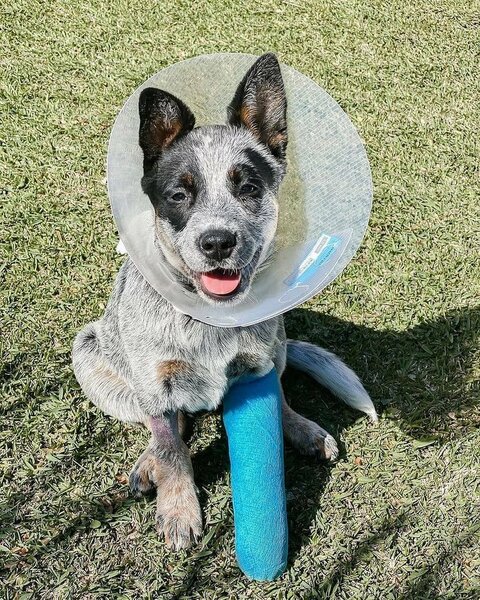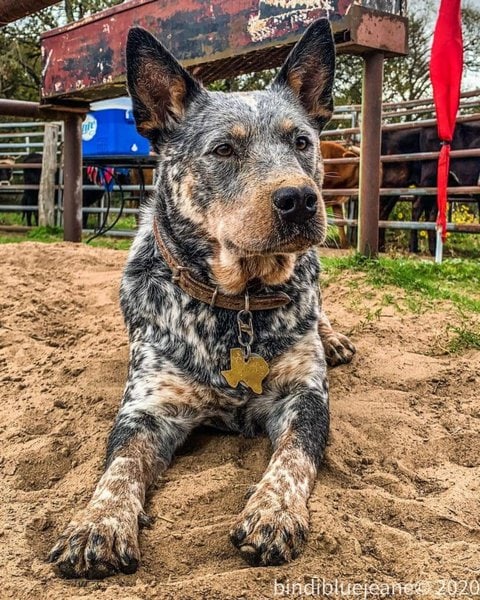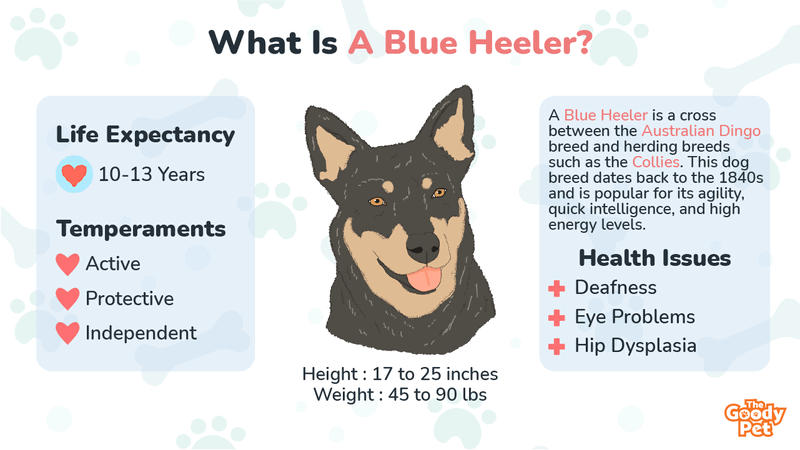If you have an active lifestyle, a Blue Heeler may just be the perfect companion for you. The Blue Heeler, also known as the Australian Cattle dog, is an energetic and intelligent herding breed.
The Australian Cattle Dog is a result of crossing the Dingo breed native to Australia with domestic breeds such as the Collie, Bull Terrier, and Kelpie. This cross between the sturdy and active Dingoes with domestic breeds like the Collies resulted in the loyal, energetic, and intelligent breed that is the Blue heeler.
Australian Cattle Dogs, or Blue Heelers, were initially bred to herd cattle. This means that Blue Heelers are a working breed that needs plenty of room and exercise to thrive. However, there is a lot more to this breed than their hyper energy. Before you consider bringing one home, here is everything you need to know about the Blue Heeler.
What Is A Blue Heeler?

History
A Blue Heeler is a cross between the Australian Dingo breed and herding breeds like the Collies.
This dog breed dates back to the 1840s and is popular for its agility, quick intelligence, and high energy levels.
Since Blue Heelers are part of Dingo, they have the general herding instincts that can make them a handful if they are not properly trained.
Size
Blue heelers are often categorized under middle-sized dog breeds.
Their average height ranges from 16 to 20 inches while their weight is usually between 35 and 60 pounds.
Like most middle-sized breeds, Blue Heelers are energetic and can be rambunctious. This breed is very active and will not do well as a lap dog.
If you need an active pooch that can be your jogging companion or hiking buddy, a Blue Heeler is perfect for the job.
Personality
A Blue Heeler is a sturdy and energetic breed that owes some of its traits to its Dingo ancestry.
Blue heelers are affectionate and loyal companions, but they also need plenty of room and exercise.
If you live in a small apartment, this may not be the breed to go for. This breed thrives in large spaces with plenty of physical and mental stimulation.
Blue heelers make great guard dogs. They are very loyal and protective of their owners. If you are looking for a guard dog, look no further than the Blue Heelers.
On the flip side, their protective nature makes this breed wary of strangers and this can turn to aggression.
How Long Do Blue Heelers Live? Common Health Problems Of A Blue Heeler

The life expectancy of a Blue Heeler ranges between 10 to 13 years.
Blue Heelers are a sturdy and resilient breed that will thrive with the right nutrition and care.
If your pooch gets a healthy and balanced diet coupled with a regular exercise regimen, you can expect them to live a long and healthy life.
Despite their sturdy nature, Blue Heelers are susceptible to some health conditions. These health problems are usually due to genetic traits. These include:
- Hip dysplasia
- Eye problems
- Deafness
Hip Dysplasia
Active breeds like the Blue heeler are prone to joint and muscle problems.
This means that your Blue heeler will be susceptible to conditions such as hip dysplasia. This condition tends to develop later in life.
If your pooch starts to exhibit symptoms such as muscle stiffness, limping, or lethargy, they may be suffering from hip dysplasia.
Retinal Atrophy
Blue heelers are susceptible to vision problems.
Retinal atrophy in Blue heelers can lead to blurring of vision and, in some cases blindness. This condition occurs when the retina progressively deteriorates.
Regular eye check-ups are recommended for Blue Heelers so that any eye problems can be detected and treated early.
Deafness
Deafness is a common health problem in Blue Heelers. This condition is usually due to an inherited autosomal recessive trait.
Some Blue Heelers may lose hearing in one ear, while others may experience complete deafness.
If your pooch is experiencing hearing loss, you will notice behavioral changes such as excessive barking and a lack of responsiveness to noises and commands.
Do Blue Heelers Shed A Lot? Grooming Tips Of A Blue Heeler

Blue Heelers are pretty low maintenance in terms of grooming so you do not have to fret about hours of grooming with these energetic pups.
Your Blue Heeler will have a short double coat that is both water and dirt resistant. A Blue Heelers coat is perfectly adapted to the outdoors and you will find that your pooch can stay clean for extended periods with minimal grooming.
Brushing
Blue Heelers do not shed a lot. They will normally shed twice a year in the spring and fall.
Brushing your Blue Heeler once a week is sufficient to keep his coat clean and healthy.
If you do not like having dog hair all over your furniture and home, regular weekly brushing will ensure that your pooch is free of loose hairs
Bathing
A Blue Heeler should be bathed at least once every 4 to 6 weeks.
Since this breed has short coats, they do not get dirty quickly, and they do not need weekly baths.
However, if your Blue Heeler is rambunctious and gets dirty often, you may bathe them as needed.
Always clean your pup’s ears to keep away infections. Any signs of redness inside the ear may be a sign of infection and should be looked at by your vet.
Teeth And Nails
Your Blue Heeler should have their teeth brushed no less than once a week; this will help to avoid dental issues and keep the doggie’s breath to a minimum. Trimming and clipping of nails should also be done as needed to make sure your pooch is well-groomed and clean at all times.
Blue Heeler Temperament 101
Blue Heelers are great companions, but they also have caveats that any potential owner needs to keep in mind.
Aggressive
Blue heelers are territorial, and this can make them prone to aggression.
Blue heelers are also extremely wary of strangers. This may be a great trait in a guard dog, but it also means that your pooch may be aggressive toward other dogs and strangers.
To overcome aggression, your Blue Heeler will need plenty of socialization.
Intelligent And Alert
Blue heelers are anything but dull. These intelligent pups will often surprise you with their level of intuitiveness.
They do need lots of mental stimulation to keep them occupied, so toys and playtime are a necessity.
Active
Blue Heelers are active and energetic dogs. They love to run around, chase, and generally live on their feet. This rambunctious nature can make them a handful, especially for new owners.
Protective
Blue heelers are very protective of their owners and this is why they make excellent guard dogs. They are very loyal and may even become overprotective of their owners.
Independent
If you are looking for a lap dog, you may want to give Blue Heelers a pass. These pups tend to be independent and are content to spend time with you without being cuddled.
Prone To Separation Anxiety
Blue heelers are pack animals and do not do well alone. Your Blue Heeler will follow you around because of his pack mentality. This natural instinct to exist in a pack makes Blue Heelers prone to separation anxiety.
How Do You Calm A Blue Heeler?
Plenty Of Exercise
Blue Heelers can wear you down with their exuberance and hyperactivity. To calm down your Blue Heeler you will need to make sure they get plenty of exercise and mental stimulation.
A simple walk is not enough to keep these energetic pups calm. Jogging, hikes, and plenty of playtime are all necessary to keep your Blue Heeler calm.
Lots Of Space
Blue Heelers were bred to be to herd cattle. This means they need an active lifestyle and lots of space to release pent-up energy.
Make sure you have plenty of room in your home for your Blue Heeler to run around in and explore.
This breed does not do well in apartments, so do not get a Blue Heeler if you have limited living space.
Take your pooch to the dog park often. A leash will make sure your pooch does not wander or chase after everything in sight.
Plenty Of Toys
Intelligent dogs like Blue Heelers get bored easily. Make sure your pooch has plenty of toys to keep them occupied.
Obedience Training
Obedience training is important especially when it comes to cattle dogs. Blue heelers have a natural instinct to chase and herd.
This makes them prone to biting and nipping at heels. To stop your Blue Heeler puppy from biting, make sure they are trained.
Puppies are easier to train than adult dogs, so always start obedience training early.
Related Questions
Are Red Heelers More Aggressive Than Blue? No, Red heelers are not more aggressive than Blue Heelers. Both are Australian Cattle Dogs which means that they are the same breed with the same temperament. The only difference between Red and Blue Heelers is the color of their coats.
How Much Does A Blue Heeler Cost? The average cost of a Blue Heeler is $500. Depending on the breeder and pedigree, this cost can go up to $5,000. Show quality Blue Heelers will typically cost between $1,800 to $5,000.
How Smart Is A Blue Heeler? Blue heelers are very smart dogs that have been rated 10th smartest in terms of intelligence and obedience by canine psychologist Stanley Coren in his book on the intelligence of dogs. Blue Heelers tend to be very intuitive and are widely regarded as one of the best cattle herding breeds.





